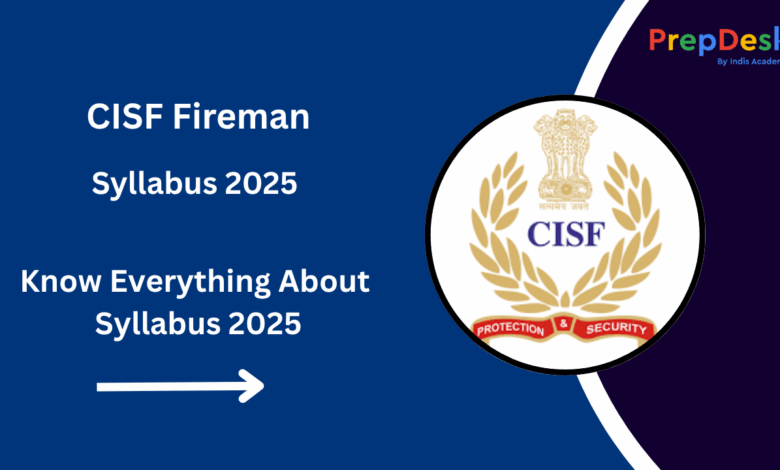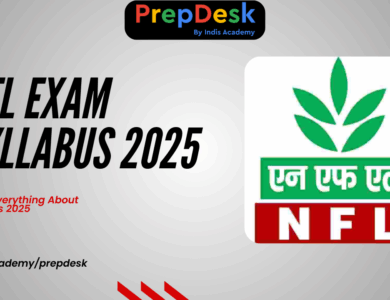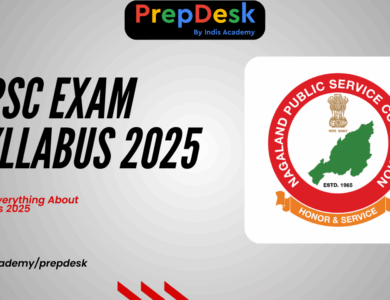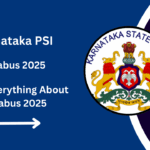CISF Fireman Syllabus 2025 – Subject-wise PDF & Pattern
Explore the complete CISF Fireman Syllabus 2025 including subject-wise topics, exam pattern, marks distribution, and PDF download. Get detailed preparation tips, recommended books, and strategy to crack the Fireman exam.

The Central Industrial Security Force (CISF) conducts recruitment for the post of Fireman/Constable (Fire) to manage fire safety and emergency services across India’s strategic infrastructure. Candidates applying for this post must go through a multi-stage selection process, and understanding the CISF Fireman syllabus is crucial for effective preparation.
This article provides a complete breakdown of the CISF Fireman syllabus 2025, including exam pattern, subject-wise topics, marks distribution, topic descriptions, syllabus PDF download, best books, preparation tips, specialization, and more.
CISF Fireman Exam Overview
| Component | Details |
|---|---|
| Exam Conducting Body | Central Industrial Security Force (CISF) |
| Post Name | Constable (Fire)/Fireman |
| Selection Process | PET/ PST, Written Exam, Document Verification, Medical |
| Written Exam Mode | OMR-based (Offline) |
| Written Exam Duration | 2 hours (120 minutes) |
| Total Marks | 100 marks |
| Number of Questions | 100 questions |
| Negative Marking | No negative marking |
| Official Website | https://cisf.gov.in |
CISF Fireman Exam Pattern 2025
The written exam is objective in nature and consists of four major sections:
| Section | No. of Questions | Marks | Duration |
|---|---|---|---|
| General Intelligence & Reasoning | 25 | 25 | 120 Minutes |
| General Knowledge & Awareness | 25 | 25 | |
| Elementary Mathematics | 25 | 25 | |
| English/Hindi Language | 25 | 25 | |
| Total | 100 | 100 | 2 Hours |
CISF Fireman Subject-Wise Syllabus with Topics & Descriptions
1. General Intelligence & Reasoning
| Topics | Description |
|---|---|
| Analogies | Test understanding of relationship between pairs. |
| Similarities and Differences | Identify similar or different patterns. |
| Spatial Visualization | Ability to visualize objects in different orientations. |
| Spatial Orientation | Recognize direction and spatial positions. |
| Problem Solving | Logical and analytical problem-solving skills. |
| Analysis | Drawing logical conclusions from data. |
| Judgment | Making accurate decisions and judgments. |
| Decision Making | Evaluate different situations logically. |
| Visual Memory | Remember visual sequences or images. |
| Discrimination | Identify differences in elements. |
| Observation | Attention to detail in patterns or information. |
| Relationship Concepts | Understanding blood relations, directions, etc. |
| Arithmetical Reasoning | Logical reasoning using numerical concepts. |
| Verbal and Figure Classification | Classifying elements based on features. |
| Arithmetic Number Series | Identify patterns in number sequences. |
| Non-verbal Series | Identify patterns in non-verbal figures. |
2. General Knowledge & Awareness
| Topics | Description |
|---|---|
| Current Affairs | National and international events, sports, etc. |
| Indian History | Ancient, medieval, and modern history of India. |
| Geography | Indian and world geography, physical features. |
| Indian Polity | Constitution, political system, Panchayati Raj, etc. |
| Indian Economy | Basic economic principles and developments. |
| Science & Technology | Basics of physics, chemistry, biology. |
| Environmental Studies | Environmental issues, ecology, conservation. |
| Static GK | Books, authors, awards, important dates. |
3. Elementary Mathematics
| Topics | Description |
|---|---|
| Number System | Integers, fractions, LCM, HCF. |
| Simplification | BODMAS and arithmetic expressions. |
| Percentage | Finding and comparing percentages. |
| Ratio and Proportion | Basic applications and calculations. |
| Averages | Calculation and application-based problems. |
| Simple and Compound Interest | Interest-based calculations. |
| Profit and Loss | Trade-related numerical questions. |
| Time and Work | Work efficiency, task completion. |
| Time, Speed, and Distance | Relative speed and average speed. |
| Mensuration | Area and volume of 2D and 3D shapes. |
| Algebra | Basic algebraic identities and expressions. |
| Geometry | Basic geometric properties and theorems. |
4. English/Hindi Language
(Candidates can choose either English or Hindi based on preference)
English Language
| Topics | Description |
|---|---|
| Reading Comprehension | Understand and analyze passages. |
| Fill in the Blanks | Grammar-based sentence completion. |
| Synonyms & Antonyms | Vocabulary and word usage. |
| Error Spotting | Identify grammatical errors. |
| Sentence Improvement | Correcting sentence structure. |
| Idioms and Phrases | Common phrases and meanings. |
| One Word Substitution | Replace phrases with single words. |
Hindi Language
| विषय | विवरण |
|---|---|
| गद्यांश | पैराग्राफ पढ़कर प्रश्नों के उत्तर देना |
| वाक्य संशोधन | वाक्य में त्रुटियाँ ढूंढना और सुधारना |
| पर्यायवाची और विलोम | समानार्थी और विपरीत अर्थ वाले शब्द |
| मुहावरे और लोकोक्तियाँ | प्रचलित कहावतें और उनके अर्थ |
| रिक्त स्थान पूर्ति | वाक्य में उचित शब्द भरना |
| समास | संयुक्त शब्दों की संरचना |
| उपसर्ग और प्रत्यय | शब्द निर्माण में प्रयुक्त भाग |
CISF Fireman Syllabus PDF Download
To download the official CISF Fireman Syllabus PDF 2025, click the link below:
Download CISF Fireman Syllabus PDF
Recommended Books for CISF Fireman Exam 2025
| Subject | Book Title | Author/Publisher |
|---|---|---|
| General Intelligence | A Modern Approach to Verbal & Non-Verbal Reasoning | R.S. Aggarwal |
| General Knowledge | Lucent’s General Knowledge | Dr. Binay Karna |
| Mathematics | Quantitative Aptitude | R.S. Aggarwal |
| English Language | Objective General English | S.P. Bakshi (Arihant) |
| Hindi Language | Samanya Hindi | Arihant Publications |
| Current Affairs | Pratiyogita Darpan (Monthly) | PD Group |
Preparation Tips for CISF Fireman Exam 2025
- Know the Syllabus Thoroughly: Study the latest syllabus and create a plan accordingly.
- Make a Timetable: Allocate daily time slots for all four subjects.
- Practice Previous Year Papers: Solve old question papers and analyze your performance.
- Stay Updated: Read newspapers and watch current affairs videos regularly.
- Revise Weekly: Make notes and revise regularly to retain concepts.
- Attempt Mock Tests: Take mock tests under timed conditions every week.
Specialization and Career Growth
After joining as a Fireman, the CISF provides opportunities for career advancement:
- Leading Fireman
- Sub-Officer (Fire)
- Inspector (Fire)
- Assistant Commandant (Fire)
With experience and training, CISF Firemen can also work in:
- Industrial Fire & Safety Units
- Disaster Management Authorities
- Private Sector Safety Jobs (Post Retirement)
Conclusion
The CISF Fireman syllabus 2025 is comprehensive and demands disciplined preparation. With the right strategy, recommended books, mock tests, and time management, you can crack the exam and build a promising career in the Central Industrial Security Force.
FAQs
Q1. Is there negative marking in the CISF Fireman written exam?
No, there is no negative marking.
Q2. What is the mode of the CISF Fireman exam?
It is conducted in offline mode (OMR-based).
Q3. Can I choose Hindi as my exam language?
Yes, candidates can choose either Hindi or English.
Q4. How many marks are required to qualify?
Minimum qualifying marks are usually 35% for General and 33% for reserved categories, but are subject to CISF rules.





